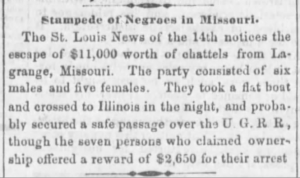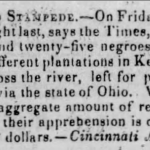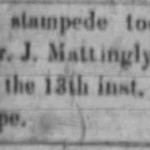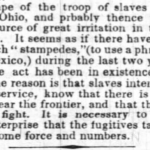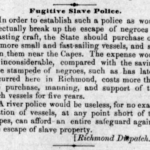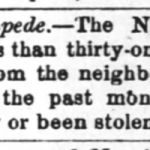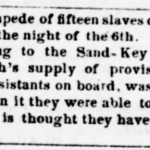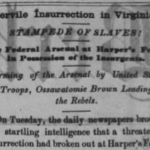Search Summary
- Search conducted by Cooper Wingert between June 28, 2019-July 16, 2019
- Keywords: slave stampede
- Totals: Approximately 600 hits, with concentrations of stampede attempts from Kentucky, Virginia, Maryland and Missouri.
- NOTE: Due to extensive results, this search was stopped at December 1859. We still need to complete the database report with the war years.
Top Results
- “A regular stampede took place among the slaves of Mr. J. Mattingly, near St. Louis, on the night of the 13th inst. Seven of them made their escape.” (Marshall, TX Texas Republican, July 31, 1852)
- Quoting the St. Louis Democrat, the Pittsburgh Gazette printed an article headlined “Stampede Among the Africans.” Noting that “some fifteen or twenty slaves departed this city [St. Louis] for the colder climates of the north,” the paper reported that the freedom seekers “probably decamped about midnight, having, under the permission of their owners to attend church, gathered themselves together and set out in a company. Heavy rewards have been offered by their owners, and officers are in close pursuit of them.” (St. Louis Democrat, quoted in “Stampede Among the Africans,” Pittsburgh, PA Gazette, October 30, 1854)
- In late 1854, the Milwaukee Weekly Wisconsin reported that “the St. Louis papers are very much exercised over the frequent stampede of slaves, and their almost impossible recovery after they once get as far as Chicago….” (Milwaukee, Wi Weekly Wisconsin, December 20, 1854)
- “In Missouri, surrounded as she is by free States, stampedes of slaves are of frequent occurrence. You cannot take up one of the city papers without seeing an advertisement with its accompanying reward for the recovery of runaway slaves.” (St. Louis Central Christian Advocate, February 2, 1859, quoted in “Missouri and Slavery,” Chicago Tribune, February 9, 1859)
- In November 1859, a Glasgow, Missouri paper reported a “negro stampede” of 11 enslaved people from La Grange, Missouri. “The fugitives stole a flat boat from this place, in which it is supposed they crossed the river.–The boat was caught at or near Quincy. If these slaves succeed in making a permanent escape, it will be the third or fourth successful stampede that has taken place from LaGrange in the past three of four months.” (“Negro Stampede,” Glasgow, MO Weekly Times, November 17, 1859)
- Quoting from the Cincinnati Atlas, a Vermont serial published an article titled “Grand Stampede.” Noting that “between twenty and twenty-five negroes, belonging to different plantations in Kenton Co. Ky., across the river, left for parts unknown, via the state of Ohio.” (Cincinnati Atlas, quoted in “Grand Stampede,” Danville, VT North Star, May 17, 1847)
- A Washington, D.C. paper reported that “a stampede of negro slaves took place at Maysville, Ky., a few days ago. They are gone to help to people the wilds of Ohio and Canada.” (Washington, D.C. Daily National Whig, May 26, 1847)
- Reporting an escape of 20 enslaved people near Baltimore, the Charleston Courier related: “These stampedes are becoming every day occurrences.” (Charleston, SC Courier, quoted in New Orleans Weekly Delta, September 18, 1848)
- An article titled “Stampede” in the Carlisle, Pennsylvania Herald reported “a great commotion among the slave owners of Maryland, in consequence of the large numbers of slaves who have seen proper to take ‘French leave’ of their masters, and emigrate into free states. The papers published in border counties come teeming full of advertisements offering rewards for runaways, and editorial notices of the absconding of whole gangs and families of slaves, who are seldom ever caught, and only heard of when safe far north of Mason & Dixon’s line…. Several instances have occurred lately, of gangs of slaves having run away in one night, and successfully got off, whose value would be from 5,000 to $8,000.” (“Stampede,” Carlisle, PA Weekly Herald, September 19, 1849)
- While noting that the escape of a “troop of slaves from Kentucky into Ohio” would “be a source of great irritation in that part of the country,” a correspondent for the New York Times commented that “there have been more cases of such ‘stampedes,’ (to use a phrase imported from Mexico,) during the last two years, since the Fugitive act has been in existence, than ever before.” (“Washington,” New York Times, October 4, 1852)
- Reporting that “several negro stampedes have recently taken place in different parts the State,” the Kentucky Yeoman noted “the negroes are running away in scores, assisted and urged on, doubtless, by northern abolitionists…. If they continue their negro-stealing and negro-harboring business at the present rate, and their orators are permitted to canvas Kentucky and preach their incendiary doctrines to our slaves, the result will ere long be terrible. The people of Kentucky will not quietly submit to such robberies.” (Kentucky Yeoman, “Negro Stampedes,” Huntsville, AL Democrat, October 21, 1852)
- Grappling with the frequency of escapes, the Richmond Dispatch somewhat sarcastically proposed forming a “fugitive slave police” by commissioning “one or more small and fast-sailing vessels,” which would be stationed “near the Capes.” The paper groused that “one stampede of negroes, such as has lately occurred here in Richmond, costs more than the purchase, manning, and support of two such vessels for five years.” (Richmond Dispatch, quoted in Washington, D.C. National Era, “Fugitive Slave Police,” May 5, 1854)
- “On Saturday night a serious stampede of slaves occurred in Richmond. Five likely and valuable slaves made off to parts unknown, one of them taking $1506 of his master’s money with him.” (Vicksburg, MS Vicksburg Daily Whig, February 13, 1855)
- A parody “procession” or parade described by a Buffalo, New York newspaper included the “Editor of the Cincinnati Commercial, with a model of a cotton boat and a slave stampede.” (Buffalo, NY Daily Republic, July 3, 1855)
- A New York Times column claimed that the “silent operations of the ‘Underground Railroad'” were exercising a “powerful effect in Maryland, Virginia, Delaware, and Kentucky,” where “stampedes have become more frequent than ever, and the border counties of the Slave States are fast losing their laboring population.” (“The Underground Railroad,” New York Times, November 30, 1855)
- The Buffalo, New York Morning Express used the term “Servile Stampede” when reporting the escape of 11 enslaved people from Loudon County, Virginia. (“Servile Stampede,” Buffalo, NY Morning Express, September 23, 1856)
- In December 1856, the Baltimore Sun used the terms “stampede” and “insurrection” interchangeably. While noting “the arrest of two negro men suspected of plotting an insurrection among the blacks,” the paper suggested that “it would be well for the organized patrol parties to be vigilant, lest a ‘stampede’ in some quarter might take place.” (“An Excitement,” Baltimore Sun, December 6, 1856)
- In June 1857, a Mississippi paper reported a “negro stampede” consisting of “no less than thirty-one negroes” who had “disappeared from the neighborhood of Fort Adams within the past month. They have either run away or been stolen.” (Natchez, MS Courier, quoted in “Negro Stampede,” New Orleans Times-Picayune, June 27, 1857)
- The Carlisle Herald reported a “stampede” of “eleven runaway slaves, from Carroll county, Maryland” who “passed through the principal street of Carlisle. Their masters were here on Monday in hot pursuit.” (“Stampede of Slaves,” Carlisle, PA Weekly Herald, October 7, 1857)
- The Washington, D.C. Evening Star noted “a stampede of slaves took place from this city on Saturday night. From the number that is missing, it is thought that they were taken away in some northern vessel.” (Washington, D.C. Evening Star, July 28, 1859)
- In the immediate wake of John Brown’s October 1859 Harpers Ferry raid, many papers reported the incident as an attempted stampede. “The idea was to hold the town long enough to concentrate the negroes by hundreds and thousands from miles around,” reported a Connecticut paper, “and then, when retreat became necessary, make a grand stampede across the Maryland line into Pennsylvania.” (Hartford, CT Courant, October 19, 1859)
Select Images
- Danville VT North Star, May 17, 1847 (Newspapers.com)
- Washington D.C. National Whig, May 26, 1847 (Newspapers.com)
- Marshall, TX Texas Republican, July 31, 1852 (Newspapers.com)
- New York Times, October 4, 1852 (Newspapers.com)
- Washington DC National Era, May 3, 1854 (Newspapers.com)
- Buffalo NY Morning Express, September 28, 1856 (Newspapers.com)
- New Orleans Times-Picayune, June 27, 1857 (Newspapers.com)
- Carlisle PA Weekly Herald, October 7, 1857 (Newspapers.com)
- Washington D.C. Evening Star, February 18, 1858 (Newspapers.com)
- Gettysburg PA Adams Sentinel, October 10, 1859 (Newspapers.com)
- Pittsfield MA Berkshire County Eagle, October 20, 1859 (Newspapers.com)
- Glasgow MO Weekly Times, November 17, 1859 (Newspapers.com)
General Notes
- Newspapers.com is a subscription database.
- Stampedes could also head for destinations to the south. “Texas negroes, of late, are in the habit of running off to Mexico in droves,” reported a Pennsylvania paper, “tempted thither by wandering tribes of women, wandering about like gypsies. So it is said. The slaveholders, however, are organizing, to prevent a continuance of the stampede.” (Towanda, PA Bradford Reporter, October 28, 1854)
- Likewise, a Washington, D.C. serial reported “a stampede of fifteen slaves” from Key West, Florida. “A small sail boat, belonging to the Sand-Key Lighthouse, with a month’s supply of provisions for the keeper and assistants on board, was taken by the negroes, and in it they were able to elude their pursuers. It is thought they have gone to Nassau.” (Washington, D.C. Evening Star, February 18, 1858)
- The term was also used to describe the “stampede” of slaves being sold farther south to preclude escape attempts. A Kansas newspaper detailed “a perfect stampede of slaves from Western Missouri, their masters selling them off South, or removing with them to that section.” (“Personal,” Lawrence, KS Western Home Journal, November 18, 1858)
- Describing the sale and relocation of many enslaved Missourians to locations in the deep South, a Pennsylvania paper noted that “there are upwards of four hundred slaves leaving Missouri every week, nearly all of whom go south.” Styling it “The Missouri Stampede,” the serial noted that “this movement in the slave market is occasioned partly by the high prices obtained, and partly by causes having no reference to prices.” (“The Missouri Stampede,” Gettysburg, PA Adams Sentinel, October 10, 1859)
Most Relevant Coverage from Genealogy Bank Database
- MISSOURI: Glasgow Weekly Times – 1848-1859
- ILLINOIS: Chicago Tribune – 1849-1859
- MARYLAND: Baltimore Sun – 1847-1859
- NEW YORK: Buffalo Morning Express – 1847-1859
- VIRGINIA: Richmond Dispatch – 1852-1859

